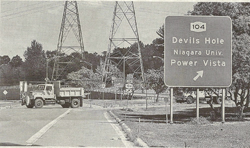Terrorist Threat in our Backyard ignored by Cuomo, State Agencies
By James Hufnagel
 |
Does the Robert Moses Parkway make the NYPA Power Plant vulnerable? |
In May of this year the Police Commissioner of New York City, Raymond W. Kelly, publicly commented on burdensome security procedures in place to screen tourists visiting the newly-reopened Statue of Liberty: "This screening was put in just after the horrific events of Sept 11. And I can tell you, in our judgment, the threat has not abated."
Closer to home, senior New York Senator Charles Schumer recently warned "Clearly, now is not the time to dial back on border and transit security" in reference to Department of Homeland Security delays in funding a Western New York anti-terrorism task force. He specifically referred to foiled terrorist attack attempts including the April, 2013 passenger train incident which imperiled citizens of the city of Niagara Falls, resulting in the arrest of two terrorists who planned to detonate an explosive device on key bridge infrastructure over the Niagara River, and the Boston Marathon bombing. "The Canadian terror plot, the Lackawanna Six and the terribly unfortunate events in Boston should make us more vigilant in New York's big cities and transit systems, not less."
It is inexplicable, therefore, why the Cuomo administration persists in keeping open the Robert Moses Parkway, a little-used roadway that traverses the center of the Niagara Power Project at Lewiston, NY. Cars, trucks and buses have unrestricted access 24 hours a day, seven days a week, over the dam, past the turbines and through the very heart of this huge hydropower facility, which supplies electric power to all of New York and several other states of the Northeast.
In the days following 9/11, the Moses Parkway at the entrance to the Power Project was blocked off by large Department of Transportation dumptrucks. Detailed schematics of the Niagara Power Project were carelessly released to the public during the relicensing process several years ago. The Parkway as it traverses the Power Project is readily visualized on various internet sites such as Google Maps. There have been numerous newspaper articles over the years, some still accessible on the internet while others have been inexplicably removed, spotlighting the vulnerability to terrorist attack unfettered vehicular access across the Power Project on the Robert Moses Parkway allows. Cumulatively, these factors make for an open invitation to terrorists, and an intolerably dangerous situation.
While it is true that a "hardening" of the critical infrastructure of the Niagara Power Project was attempted after 9/11, it did little to mitigate the danger to the facility, its workers or residents of neighboring communities. The mere publicity surrounding a successful detonation of an explosive device in the center of a large power plant in the United States would more than serve the purpose of terrorists even in the event the actual physical damage to the facility was minimal.
The record since 9/11 is replete with instances where roads across such sensitive facilities have been closed, including one traversing the Hoover Dam. Unlike the Hoover Dam, however, there are alternative roadways entering and exiting the city of Niagara Falls onto which the few hundred vehicles (According to NYS Dept. of Transportation studies, an average of one car every two minutes) that use the parkway on a daily basis could be easily be re-routed.
A scoping process exploring Parkway closure and removal has dragged on for over a decade. Now we are told there will be no decision on parkway removal for another year, and that probably will not include closure/removal over the power generating plant.
In this era of body scans at the airport, monitoring of the phone calls and emails of average citizens by federal agencies and lengthy delays at our international borders, it is unconscionable that terrorists have complete, unrestricted access to this vital component of our energy infrastructure.
Of the three "Alternatives" being considered in the scoping process for Parkway removal, only Alternative 6 requires closure of the Parkway over the Niagara Power Project. Governor Cuomo must act now to head off further terrorist threats to Western New York, and expedite the implementation of Alternative 6, closing and removing the Moses Parkway.
After all, Cuomo is plenty conscientious when it comes to his own personal safety. When visiting Western New York, as he has several times over the past year, invariably he is whisked by motorcade from the airport to the easily secured confines of either Buff State or the UB campus, where layers of campus cops and local and state police provide protection for the governor and the favored few invited to his appearances. Would that he cared so much for our safety.